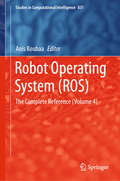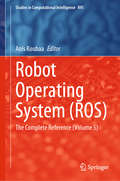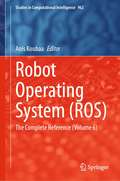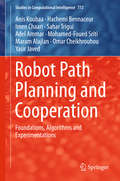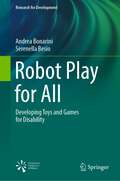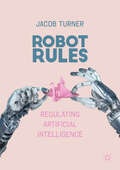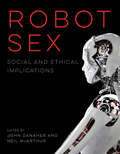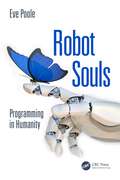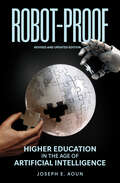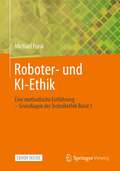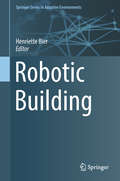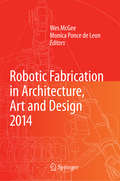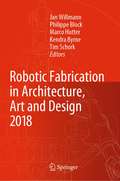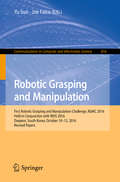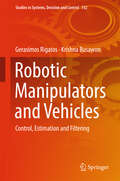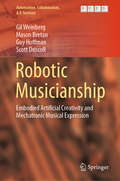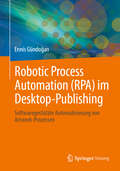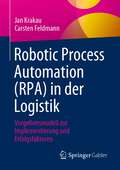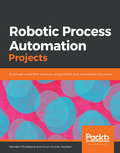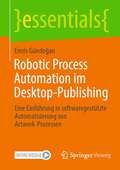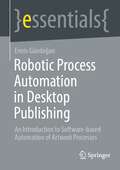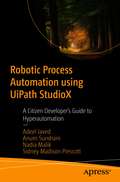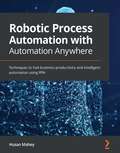- Table View
- List View
Robot Operating System: The Complete Reference (Volume 4) (Studies in Computational Intelligence #831)
by Anis KoubaaThis is the fourth volume of the successful series Robot Operating Systems: The Complete Reference, providing a comprehensive overview of robot operating systems (ROS), which is currently the main development framework for robotics applications, as well as the latest trends and contributed systems. The book is divided into four parts: Part 1 features two papers on navigation, discussing SLAM and path planning. Part 2 focuses on the integration of ROS into quadcopters and their control. Part 3 then discusses two emerging applications for robotics: cloud robotics, and video stabilization. Part 4 presents tools developed for ROS; the first is a practical alternative to the roslaunch system, and the second is related to penetration testing. This book is a valuable resource for ROS users and wanting to learn more about ROS capabilities and features.
Robot Operating System: The Complete Reference (Volume 5) (Studies in Computational Intelligence #895)
by Anis KoubaaThis book is the fifth volume in the successful book series Robot Operating System: The Complete Reference. The objective of the book is to provide the reader with comprehensive coverage on the Robot Operating System (ROS), which is currently considered to be the primary development framework for robotics applications, and the latest trends and contributing systems. The content is divided into six parts. Pat I presents for the first time the emerging ROS 2.0 framework, while Part II focuses on multi-robot systems, namely on SLAM and Swarm coordination. Part III provides two chapters on autonomous systems, namely self-driving cars and unmanned aerial systems. In turn, Part IV addresses the contributions of simulation frameworks for ROS. In Part V, two chapters explore robotic manipulators and legged robots. Finally, Part VI presents emerging topics in monocular SLAM and a chapter on fault tolerance systems for ROS. Given its scope, the book will offer a valuable companion for ROS users and developers, helping them deepen their knowledge of ROS capabilities and features.
Robot Operating System: The Complete Reference (Volume 6) (Studies in Computational Intelligence #962)
by Anis KoubaaThis book is the sixth volume of the successful book series on Robot Operating System: The Complete Reference. The objective of the book is to provide the reader with comprehensive coverage of the Robot Operating Systems (ROS) and the latest trends and contributed systems. ROS is currently considered as the primary development framework for robotics applications. There are seven chapters organized into three parts. Part I presents two chapters on the emerging ROS 2.0 framework; in particular, ROS 2.0 is become increasingly mature to be integrated into the industry. The first chapter from Amazon AWS deals with the challenges that ROS 2 developers will face as they transition their system to be commercial-grade. The second chapter deals with reactive programming for both ROS1 and ROS. In Part II, two chapters deal with advanced robotics, namely on the usage of robots in farms, and the second deals with platooning systems. Part III provides three chapters on ROS navigation. The first chapter deals with the use of deep learning for ROS navigation. The second chapter presents a detailed tuning guide on ROS navigation and the last chapter discusses SLAM for ROS applications. I believe that this book is a valuable companion for ROS users and developers to learn more ROS capabilities and features.
Robot Operating System: The Complete Reference (Volume 7) (Studies in Computational Intelligence #1051)
by Anis KoubaaThis book is the seventh volume of the successful book series on Robot Operating System: The Complete Reference, which started in 2016. The book's objective is to provide the reader with comprehensive coverage on the Robot Operating Systems (ROS) and the latest trends and contributed systems. ROS has been considered as the primary development framework for robotics applications.There are seven chapters organized into three parts. Part I presents one chapter dealing with ROS2 and presents a tutorial on using the MediaPipe framework with ROS2. In Part II, three chapters present new contributions of ROS frameworks and applications, including micro-ROS, Autonomous 3D Thermal Mapping of Disaster Environments, and Lab-scale Smart Factory Implementation Using ROS. Part III provides contributions on how to use ROS for cooperative robotics behaviors, particularly in platoon applications, in addition to developing new perception and control algorithms with sensing technologies. This book will be a valuable companion for ROS users and developers to learn more about ROS capabilities and features.
Robot Path Planning and Cooperation: Foundations, Algorithms And Experimentations (Studies In Computational Intelligence #772)
by Anis Koubaa Hachemi Bennaceur Imen Chaari Sahar Trigui Adel Ammar Mohamed-Foued Sriti Maram Alajlan Omar Cheikhrouhou Yasir JavedThis book presents extensive research on two main problems in robotics: the path planning problem and the multi-robot task allocation problem. It is the first book to provide a comprehensive solution for using these techniques in large-scale environments containing randomly scattered obstacles. The research conducted resulted in tangible results both in theory and in practice. For path planning, new algorithms for large-scale problems are devised and implemented and integrated into the Robot Operating System (ROS). The book also discusses the parallelism advantage of cloud computing techniques to solve the path planning problem, and, for multi-robot task allocation, it addresses the task assignment problem and the multiple traveling salesman problem for mobile robots applications. In addition, four new algorithms have been devised to investigate the cooperation issues with extensive simulations and comparative performance evaluation. The algorithms are implemented and simulated in MATLAB and Webots.
Robot Play for All: Developing Toys and Games for Disability (Research for Development)
by Andrea Bonarini Serenella BesioThis book presents a comprehensive guide to the design of playing robots and the related play experiences. Play is a natural activity for building and improving abilities, and it reveals important particularly for persons with disabilities. Many social, physical and cultural factors may hinder children with disabilities from fully enjoying play as their peers. Autonomous robots with specific characteristics can enhance the ludic experience, having implications for the character of the play and presenting opportunities related to autonomy and physical movement, the very nature of robots. Their introduction into play thus provides everybody, and in particular persons with disabilities, new possibilities for developing abilities, improving general status, participating in social contexts, as well as supporting professionals in monitoring progress. This book presents a framework for the design of playful activities with robots, developed over 20 years’ experience at AIRLab - POLIMI. Part 1 introduces the play concepts and characteristics, and research results about play of children with different kinds of impairments. Part 2 focuses on implementing robots able to play. The design of playful activities is discussed, as well as the necessary characteristics for them to be useful in both general play and activities involving disability-related limitations. In Part 3, the defined framework is used to analyze possibilities involving robots available on the toy market, robots developed at research labs, and robots to be developed in the next future. The aim of the book is to give developers, caregivers, and users a set of methodological tools for selecting, exploring, and designing inclusive play activities where robots play a central role.
Robot Rules: Regulating Artificial Intelligence In The 21st Century
by Jacob TurnerThis book explains why AI is unique, what legal and ethical problems it could cause, and how we can address them. It argues that AI is unlike is any other previous technology, owing to its ability to take decisions independently and unpredictably. This gives rise to three issues: responsibility—who is liable if AI causes harm; rights—the disputed moral and pragmatic grounds for granting AI legal personality; and the ethics surrounding the decision-making of AI. The book suggests that in order to address these questions we need to develop new institutions and regulations on a cross-industry and international level. Incorporating clear explanations of complex topics, Robot Rules will appeal to a multi-disciplinary audience, from those with an interest in law, politics and philosophy, to computer programming, engineering and neuroscience.
Robot Sex: Social and Ethical Implications
by John Danaher Neil McArthurPerspectives from philosophy, psychology religious studies, economics, and law on the possible future of robot-human sexual relationships. Sexbots are coming. Given the pace of technological advances, it is inevitable that realistic robots specifically designed for people's sexual gratification will be developed in the not-too-distant future. Despite popular culture's fascination with the topic, and the emergence of the much-publicized Campaign Against Sex Robots, there has been little academic research on the social, philosophical, moral, and legal implications of robot sex. This book fills the gap, offering perspectives from philosophy, psychology, religious studies, economics, and law on the possible future of robot-human sexual relationships. Contributors discuss what a sex robot is, if they exist, why we should take the issue seriously, and what it means to “have sex” with a robot. They make the case for developing sex robots, arguing for their beneficial nature, and the case against it, on religious and moral grounds; they consider the subject from the robot's perspective, addressing such issues as consent and agency; and they ask whether it is possible for a human to form a mutually satisfying, loving relationship with a robot. Finally, they speculate about the future of human-robot sexual interaction, considering the social acceptability of sex robots and the possible effect on society. Contributors Marina Adshade, Thomas Arnold, Julie Carpenter, John Danaher, Brian Earp, Lily Eva Frank, Joshua Goldstein, Michael Hauskeller, Noreen Herzfeld, Neil McArthur, Mark Migotti, Sven Nyholm, Ezio di Nucci, Steve Petersen, Anders Sandberg, Matthias Scheutz, Litska Strikwerda, Nicole Wyatt
Robot Souls: Programming in Humanity
by Eve PooleTwo of the biggest design problems in Artificial Intelligence are how to build robots that behave in line with human values and how to stop them ever going rogue. One under-explored solution to these alignment and control problems might be to examine how these are already addressed in the design of humans. Looking closely at the human blueprint, it contains a suite of capacities that are so clumsy they have generally been kept away from AI. It was assumed that robots with features like emotions and intuition, that made mistakes and looked for meaning and purpose, would not work as well as robots without this kind of code. But on considering why all these irrational properties are there, it seems that they emerge from the source code of soul. Because it is actually this ‘junk’ code that makes us human and promotes the kind of reciprocal altruism that keeps humanity alive and thriving. Robot Souls looks at developments in AI and reviews the emergence of ideas of consciousness and the soul. It places our ‘junk code’ in this context and argues that it is time to foreground that code, and to use it to look again at how we are programming AI.
Robot Teams: From Diversity to Polymorphism
by Tucker Balch Lynne E. ParkerThis is a comprehensive volume on robot teams that will be the standard reference on multi-robot systems. The volume provides not only the essentials of multi-agent robotics theory but also descriptions of exemplary implemented systems demonstrating the key concepts of multi-robot research. Information is presented in a descriptive manner and augme
Robot-Proof, revised and updated edition: Higher Education in the Age of Artificial Intelligence
by Joseph E. AounA fresh look at a “robot-proof” education in the new age of generative AI.In 2017, Robot-Proof, the first edition, foresaw the advent of the AI economy and called for a new model of higher education designed to help human beings flourish alongside smart machines. That economy has arrived. Creative tasks that, seven years ago, seemed resistant to automation can now be performed with a simple prompt. As a result, we must now learn not only to be conversant with these technologies, but also to comprehend and deploy their outputs. In this revised and updated edition, Joseph Aoun rethinks the university’s mission for a world transformed by AI, advocating for the lifelong endeavor of a “robot-proof” education. Aoun puts forth a framework for a new curriculum, humanics, which integrates technological, data, and human literacies in an experiential setting, and he renews the call for universities to embrace lifelong learning through a social compact with government, employers, and learners themselves. Drawing on the latest developments and debates around generative AI, Robot-Proof is a blueprint for the university as a force for human reinvention in an era of technological change—an era in which we must constantly renegotiate the shifting boundaries between artificial intelligence and the capacities that remain uniquely human.
Roboter- und KI-Ethik: Eine methodische Einführung – Grundlagen der Technikethik Band 1
by Michael FunkWas ist die Ethik der Roboter? Was ist KI-Ethik? Was sind „moralische Maschinen“? Welchen Gesetzen sollen sie folgen? Haben wir die Roboter, die wir brauchen, und brauchen wir die Roboter, die wir haben?In vorliegendem Buch werden Grundlagen der Ethik im Umgang mit Robotern, Drohnen und KI allgemeinverständlich dargestellt. Hierzu zählt die Unterscheidung von Moral, Ethik und Ethos sowie deren Anwendung auf Menschen und Maschinen. Kriterien, Fehlschlüsse und Robotergesetze werden vorgestellt, wie auch in die umfassende Gegenwartsdebatte übersichtlich eingeführt. Grafiken und Beispiele bieten Orientierung in einem hochaktuellen und komplexen Feld.Als methodische Einführung richtet sich vorliegendes Buch an Ingenieurwissenschaftler*innen, Informatiker*innen und Geisteswissenschaftler*innen im Berufsalltag, aber auch an interessierte Lai*innen, die Grundlagen der Ethik kennen lernen wollen. Es bildet den ersten, in sich abgerundeten Teil der Buchreihe Grundlagen der Technikethik.Mit einem Geleitwort von Yvonne Hofstetter.
Robotic Building (Springer Series in Adaptive Environments)
by Henriette BierThe first volume of the Adaptive Environments series focuses on Robotic Building, which refers to both physically built robotic environments and robotically supported building processes. Physically built robotic environments consist of reconfigurable, adaptive systems incorporating sensor-actuator mechanisms that enable buildings to interact with their users and surroundings in real-time. These require Design-to-Production and Operation chains that are numerically controlled and (partially or completely) robotically driven. From architectured materials, on- and off-site robotic production to robotic building operation augmenting everyday life, the volume examines achievements of the last decades and outlines potential future developments in Robotic Building.This book offers an overview of the developments within robotics in architecture so far, and explains the future possibilities of this field. The study of interactions between human and non-human agents at building, design, production and operation level will interest readers seeking information on architecture, design-to-robotic-production and design-to-robotic-operation.
Robotic Fabrication in Architecture, Art and Design 2014
by Wes Mcgee Monica Ponce de LeonRobotic automation has become ubiquitous in the modern manufacturing landscape, spanning an overwhelming range of processes and applications-- from small scale force-controlled grinding operations for orthopedic joints to large scale composite manufacturing of aircraft fuselages. Smart factories, seamlessly linked via industrial networks and sensing, have revolutionized mass production, allowing for intelligent, adaptive manufacturing processes across a broad spectrum of industries. Against this background, an emerging group of researchers, designers, and fabricators have begun to apply robotic technology in the pursuit of architecture, art, and design, implementing them in a range of processes and scales. Coupled with computational design tools the technology is no longer relegated to the repetitive production of the assembly line, and is instead being employed for the mass-customization of non-standard components. This radical shift in protocol has been enabled by the development of new design to production workflows and the recognition of robotic manipulators as "multi-functional" fabrication platforms, capable of being reconfigured to suit the specific needs of a process. The emerging discourse surrounding robotic fabrication seeks to question the existing norms of manufacturing and has far reaching implications for the future of how architects, artists, and designers engage with materialization processes. This book presents the proceedings of Rob|Arch2014, the second international conference on robotic fabrication in architecture, art, and design. It includes a Foreword by Sigrid Brell-Cokcan and Johannes Braumann, Association for Robots in Architecture. The work contained traverses a wide range of contemporary topics, from methodologies for incorporating dynamic material feedback into existing fabrication processes, to novel interfaces for robotic programming, to new processes for large-scale automated construction. The latent argument behind this research is that the term 'file-to-factory' must not be a reductive celebration of expediency but instead a perpetual challenge to increase the quality of feedback between design, matter, and making
Robotic Fabrication in Architecture, Art and Design 2018: Foreword by Sigrid Brell-Çokcan and Johannes Braumann, Association for Robots in Architecture
by Philippe Block Marco Hutter Jan Willmann Kendra Byrne Tim SchorkThe book presents research from Rob|Arch 2018, the fourth international conference on robotic fabrication in architecture, art, and design. In capturing the myriad of scientific advances in robotics fabrication that are currently underway – such as collaborative design tools, computerised materials, adaptive sensing and actuation, advanced construction, on-site and cooperative robotics, machine-learning, human-machine interaction, large-scale fabrication and networked workflows, to name but a few – this compendium reveals how robotic fabrication is becoming a driver of scientific innovation, cross-disciplinary fertilization and creative capacity of an unprecedented kind.
Robotic Grasping and Manipulation: First Robotic Grasping and Manipulation Challenge, RGMC 2016, Held in Conjunction with IROS 2016, Daejeon, South Korea, October 10–12, 2016, Revised Papers (Communications in Computer and Information Science #816)
by Yu Sun Joe FalcoThis book constitutes the refereed proceedings of the First Robotic Grasping and Manipulation Challenge, RGMC 2016, held at IROS 2016, Daejeon, South Korea, in October 2016.The 13 revised full papers presented were carefully reviewed and are describing the rules, results, competitor systems and future directions of the inaugural competition. The competition was designed to allow researchers focused on the application of robot systems to compare the performance of hand designs as well as autonomous grasping and manipulation solutions across a common set of tasks. The competition was comprised of three tracks that included hand-in-hand grasping, fully autonomous grasping, and simulation.
Robotic Manipulators and Vehicles: Control, Estimation And Filtering (Studies in Systems, Decision and Control #152)
by Krishna Busawon Gerasimos RigatosThis monograph addresses problems of:• nonlinear control, estimation and filtering for robotic manipulators (multi-degree-of freedom rigid-link robots, flexible-link robots, underactuated, redundant and cooperating manipulators and closed-chain robotic mechanisms); and• nonlinear control, estimation and filtering for autonomous robotic vehicles operating on the ground, in the air, and on and under water, independently and in cooperating groups.The book is a thorough treatment of the entire range of applications of robotic manipulators and autonomous vehicles. The nonlinear control and estimation methods it develops can be used generically, being suitable for a wide range of robotic systems. Such methods can improve robustness, precision and fault-tolerance in robotic manipulators and vehicles at the same time as enabling the reliable functioning of these systems under variable conditions, model uncertainty and external perturbations.
Robotic Musicianship: Embodied Artificial Creativity and Mechatronic Musical Expression (Automation, Collaboration, & E-Services #8)
by Scott Driscoll Gil Weinberg Mason Bretan Guy HoffmanThis book discusses the principles, methodologies, and challenges of robotic musicianship through an in-depth review of the work conducted at the Georgia Tech Center for Music Technology (GTCMT), where the concept was first developed. Robotic musicianship is a relatively new research field that focuses on the design and development of intelligent music-making machines. The motivation behind the field is to develop robots that not only generate music, but also collaborate with humans by listening and responding in an expressive and creative manner. This combination of human and machine creativity has the potential to surprise and inspire us to play, listen, compose, and think about music in new ways. The book provides an in-depth view of the robotic platforms designed at the GTCMT Robotic Musicianship Group, including the improvisational robotic percussionists Haile and Shimon, the personal robotic companion Shimi, and a number of wearable robots, such as the Robotic Drumming Prosthesis, The Third Drumming Arm, and the Skywalker Piano Hand. The book discusses numerous research studies based on these platforms in the context of five main principles: Listen like a Human, Play Like a Machine, Be Social, Watch and Learn, and Wear It.
Robotic Process Automation (RPA) im Desktop-Publishing: Softwaregestützte Automatisierung von Artwork-Prozessen
by Ennis GündoğanDieses Buch soll dem Leser verschiedene Automatisierungsmöglichkeiten im Bereich Desktop-Publishing aufzeigen und ihn motivieren, diese in Ihren Arbeitsprozess einzube-ziehen, um die Effizienz und Effektivität ihrer Gestaltungs- bzw. Produktionsprozesse zu erhöhen. Die Methoden reichen von kleinen Hilfsmitteln wie in DTP-Software wie Adobe InDesign integrierten Skripten zur automatischen Generierung grafischer Assets bis hin zu komplexen Software-Infrastrukturen, die das automatisierte Publizieren von Tausenden von Dokumenten realisieren. Das Buch soll möglichst viele Szenarien abdecken, ein breites Publikum ansprechen und weitestgehend alle Themen rund um die Automatisierung im Desktop-Publishing kurz und prägnant abdecken. Ebenso soll das Buch mithilfe von Fall-beispielen die Effizienz und Effektivität der Automatisierung verifizieren und mehrere Blickwinkel auf DTP-bezogene Unterthemen bieten.
Robotic Process Automation (RPA) in der Logistik: Vorgehensmodell zur Implementierung und Erfolgsfaktoren
by Carsten Feldmann Jan KrakauRobotic Process Automation (RPA) bezeichnet Software-Roboter (Bots), die sich wiederholende, regelbasierte Aufgaben in einem Geschäftsprozess automatisieren. Dieses Buch beschreibt Anwendungsbereiche für RPA in der Logistik und ein Vorgehensmodell zur Implementierung von Bots in Logistikprozessen. Es beantwortet die Fragen: Was sind geeignete Anwendungsfälle für RPA in der Logistik? Welche Kriterien unterstützen die Auswahl geeigneter Prozesse? Und wie sollte ein Einführungsleitfaden gestaltet sein, um ein Implementierungsprojekt unter Berücksichtigung kritischer Erfolgsfaktoren systematisch zu unterstützen? Das Buch ist das Ergebnis eines anwendungsorientierten Forschungsprojekts zur automatisierten Ausfuhranmeldung zollpflichtiger Exportware. Es richtet sich gleichermaßen an Praktiker, Studierende und Wissenschaftler.
Robotic Process Automation Projects: Build real-world RPA solutions using UiPath and Automation Anywhere
by Nandan Mullakara Arun Kumar AsokanLearn RPA by building business solutions such as ERP and CRM automation, software robots, and intelligent process automation from scratch Key Features Use popular RPA tools Automation Anywhere A2019 and UiPath, for real-world task automation Build automation solutions for domains such as System Administration, Finance, HR, Supply Chain, and Customer Relations Extend your RPA capabilities by implementing Intelligent process automation with APIs and AI Book Description Robotic Process automation helps businesses to automate monotonous tasks that can be performed by machines. This project-based guide will help you progress through easy to more advanced RPA projects. You'll learn the principles of RPA and how to architect solutions to meet the demands of business automation, along with exploring the most popular RPA tools - UiPath and Automation Anywhere. In the first part, you'll learn how to use UiPath by building a simple helpdesk ticket system. You'll then automate CRM systems by integrating Excel data with UiPath. After this, the book will guide you through building an AI-based social media moderator using Google Cloud Vision API. In the second part, you'll learn about Automation Anywhere's latest Cloud RPA platform (A2019) by creating projects such as an automated ERP administration system, an AI bot for order and invoice processing, and an automated emergency notification system for employees. Later, you'll get hands-on with advanced RPA tasks such as invoking APIs, before covering complex concepts such as Artificial Intelligence (AI) and machine learning in automation to take your understanding of RPA to the next level. By the end of the book, you'll have a solid foundation in RPA with experience in building real-world projects. What you will learn Explore RPA principles, techniques, and tools using an example-driven approach Understand the basics of UiPath by building a helpdesk ticket generation system Automate read and write operations from Excel in a CRM system using UiPath Build an AI-based social media moderator platform using Google Cloud Vision API with UiPath Explore how to use Automation Anywhere by building a simple sales order processing system Build an automated employee emergency reporting system using Automation Anywhere Test your knowledge of building an automated workflow through fun exercises Who this book is for This RPA book is for enterprise application developers, software developers, business analysts, or any professional who wants to implement RPA across various domains of the business. The book assumes some understanding of enterprise systems. Computer programming experience will also be beneficial.
Robotic Process Automation im Desktop-Publishing: Eine Einführung in softwaregestützte Automatisierung von Artwork-Prozessen (essentials)
by Ennis GündoğanDie Automatisierung dient als eine wesentliche Komponente in der Wirtschaft, um Unternehmensziele mit qualitativ und quantitativ besseren Ergebnissen zu erreichen. Auch im Bereich des Desktop-Publishings (DTP) ist der Einsatz von Automatismen unabdingbar, um die Kosteneinsparung im Unternehmen und die Verbesserung der Endergebnisse durch Standardisierungen und Fehlerreduzierungen sowie die Entlastung der Mitarbeiter bezüglich aufwendiger und monotoner Aufgaben zu erreichen. Das vorliegende essential setzt das Ziel, die vielfältigen Möglichkeiten der Automatisierung im Bereich des DTP zusammenzufassen und legt dabei den Fokus auf sich wiederholende Artwork-Prozesse in der Druckvorstufe.
Robotic Process Automation in Desktop Publishing: An Introduction to Software-based Automation of Artwork Processes (essentials)
by Ennis GündoğanAutomation serves as an essential component in business to achieve company goals with qualitatively and quantitatively better results. The use of automation is also in the field of desktop publishing (DTP) indispensable to achieve cost savings in the company and to improve the final results through standardization and error reduction, as well as to relieve employees with regard to laborious and monotonous tasks. This essential aims to summarize the many possibilities of automation in the field of DTP, focusing on repetitive artwork processes in prepress.
Robotic Process Automation using UiPath StudioX: A Citizen Developer’s Guide to Hyperautomation
by Adeel Javed Anum Sundrani Nadia Malik Sidney Madison PrescottLearn about Robotic Processing Automation (RPA) and how to build bots using UiPath. This book uses hands-on examples to explain the basics of UiPath and then walks you through real-world prototypes for testing your knowledge.Organizations around the world are implementing RPA in some capacity, and there is a shortage of RPA developers in the market. Analysts predict that the RPA market size will be worth $4 Billion by 2025. With UiPath as one of the three major players in the RPA market, professionals and students can use this book to get ahead of the curve.This book helps you kick-start your automation journey with a special focus on one of the most popular RPA tools: UiPath. Robotic Process Automation using UiPath explains in detail the various features and functionalities of the RPA platform including development, debugging, and error handling.What You'll LearnCreate robots from scratch, using one of the market leaders in RPADevelop automation apps and deploy them to all the computers in your departmentBuild, test and perform enterprise automation tasks with UiPathUnderstand the key building blocks and components of UiPath Apply UiPath programming techniques to deploy robot configurationsReview email AutomationAutomate Excel and PDF interactionsWho This Book Is ForRPA developers and business users alike, bringing the power and skill set of automation to anyone interested in citizen-led development, specifically UiPath StudioX. The simple exercises and no-code platform require no prior programming or RPA knowledge to follow along with this beginner's guide.
Robotic Process Automation with Automation Anywhere: Techniques to fuel business productivity and intelligent automation using RPA
by Husan MaheyDiscover Automation Anywhere best practices and strategies for building scalable automation solutions for your organizationKey FeaturesBuild RPA robots using the latest features of cloud-based Automation Anywhere A2019Explore real-world scenarios with AA A2019 to understand the wide range of capabilities available for your RPA projectsBuild complete software robots to automate business processes with the help of step-by-step walkthroughsBook DescriptionWith an increase in the number of organizations deploying RPA solutions, Robotic Process Automation (RPA) is quickly becoming the most desired skill set for both developers starting their career and seasoned professionals. This book will show you how to use Automation Anywhere A2019, one of the leading platforms used widely for RPA.Starting with an introduction to RPA and Automation Anywhere, the book will guide you through the registration, installation, and configuration of the Bot agent and Control Room. With the help of easy-to-follow instructions, you'll build your first bot and discover how you can automate tasks with Excel, Word, emails, XML, and PDF files. You'll learn from practical examples based on real-world business scenarios, and gain insights into building more robust and resilient bots, executing external scripts such as VBScripts and Python, and adding error handling routines.By the end of this RPA book, you'll have developed the skills required to install and configure an RPA platform confidently and have a solid understanding of how to build complex and robust, yet performant, bots.What you will learnExplore effective techniques for installing and configuring an Automation Anywhere A2019 platformBuild software robots to automate tasks and simplify complex business processesDesign resilient bots that are modular and reusableUnderstand how to add error handling functionality and discover troubleshooting techniquesDesign bots to automate tasks in Excel, Word, emails, XML, and PDF filesImplement effective automation strategies using RPA best practicesWho this book is forThis Automation Anywhere RPA book is for automation engineers, RPA professionals, and automation consultants who are looking to explore the capabilities of Automation Anywhere for building intelligent automation strategy for enterprises. A solid understanding of programming concepts and exposure to the Automation Anywhere platform is necessary to get started with this book.
